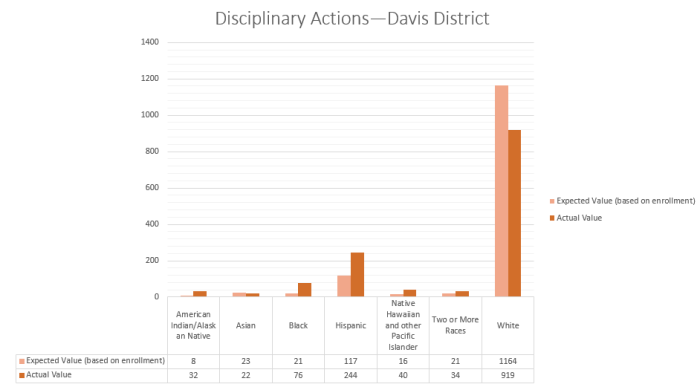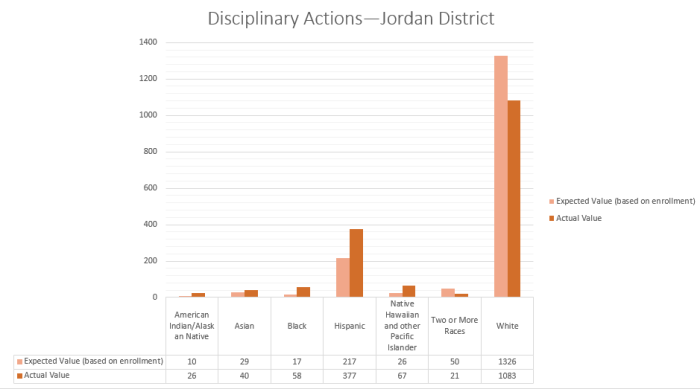Race is always a touchy subject, but one worth confronting, especially in schools. This much is clear, the 2011 OCR survey shows that there is significant statistical bias in the way children of racial minorities are impacted by suspension and expulsion nationally and even in Utah schools.
Let me be clear, this does not prove that the observed bias is the result of racism. There could be some other factor that has a disproportionate impact on these students, causing them to get into trouble at school (for example, racial gang activity). That said, we cannot rule out either racisim or unconscious bias as possible causes. Schools should evaluate their policies and safeguards in order to determine the best course of action to help these students.
Dr. Moises Prospero has been working with Canyons School District and reports encouraging results (his intervention began after OCR’s most recent data collection). Professor Emily Chiang will also be leading a research project with the S.J. Quinney College of Law’s civil rights clinic where they will look into possible solutions and recommendations that may be of use to school administrators and parents in addressing this issue.
In the U.S. Supreme Court’s recent affirmative action opinion Justice Kennedy writes, “The idea of democracy is that it can, and must, mature. Freedom embraces the right, indeed the duty, to engage in a rational, civic discourse in order to determine how best to form a consensus to shape the destiny of the Nation and its people.” I see this as a hopeful opinion that shows great faith in our Nation. However, it also places the duty on us to understand and consider where racial bias may still be present, whether it be the product of racisim, unconscious bias, or some outside force that disproportionately impacts racial minorities. As Mellody Hobson said in her TED 2014 talk, “This idea of being the land of the free and the home of the brave, it’s woven into the fabric of America. When we see a problem, we face it head on. I’m asking you to show courage, to be bold. I’m asking you not to leave any child behind, not to be color blind but to be color brave, so every child knows that their future matters and their dreams are possible.” Whatever the cause of the observed statistical bias, we cannot let these kids down by doing nothing.
I. Impact of Expulsion and Suspension
The studies on the impact of expulsion and suspensions on graduation rates are legion. A 2013 Florida study found that a single suspension drops the graduation rate from 75% to 52%. Multiple suspensions dropped the graduation rate to 38%. While the answer to the problem probably doesn’t lie in simply suspending fewer students, researchers all seem to agree that some intervention is warranted to get at the heart of these behavior problems.
The U.S. Dept. of Education’s Office of Civil Rights found that, on a national level, racial minorities are disproportionally impacted by suspension policies. But what about Utah? My law school colleague, Jade Fisher, recently published an op-ed reporting disproportionality in the statewide data, but to look deeper into the problem, I requested and analyzed the full OCR Data under the direction of Professor Chiang at the S.J. Quinney College of Law.
II. Data and Methodology
The most recent data from the OCR is from 2011. By looking at a school’s enrollment numbers by race, we can get an idea of what a proportionate disciplinary rate would be for each race. For example, if you have a hypothetical school of 110 students, 50 of which are White, 30 of which are Hispanic, 20 of which are Black, and 10 of which are Asian, then if there were 11 disciplinary actions, you would expect 5 to be taken against White students, 3 against Hispanics, 2 against Blacks, and 1 against Asians. However, in the real world, you would not expect the disciplinary rates to precisely mirror the enrollment, so we need a measure of how significant the variation is. For example, if we observed 3 disciplinary actions against Whites, 3 against Hispanics, 4 against Blacks, and 0 against Asians, are the disciplinary actions significantly disproportionate?
I used a statistical method, Pearson’s chi-squared test statistic[1], to determine the answer. This formula evaluates the observed values’ deviations from the predicted values to determine the likelihood of observing a deviation more extreme than the one observed if the hypothesis used to predict the values is true. The lower the likelihood of observing a more extreme value, the less likely it is that the hypothesis is true. In this case, this means that the lower the result from the test, the less likely it is that disciplinary actions are in proportion with enrollment for each race. In our example case above, the p value for this data is .28388 (a 28% chance of observing a more extreme result), which is definitely outside the range of statistical significance. Thus, we conclude that the disciplinary actions are not disproportionate and our hypothetical school would get an ‘A’ in our grading system.
I also looked at the number of disciplinary actions divided by the enrollment numbers of each race to determine the relative likelihood of receiving a particular disciplinary action statewide.
*[1] For any statistics nerds out there, I also used a Yate’s correction (not implemented for the hypothetical) and rounded the expected values up to the nearest whole number to avoid predicted values with absolute values smaller than 1.
III. The Results
A. Observations
First, a few interesting observations. I found that the most disproportionality occurred at the Junior High/Middle School level. In my brief discussion with Dr. Moises Prospero from the Utah Criminal Justice Center, he pointed out that this is a common age when gangs begin to target new recruits.
I also found that the more diverse the student population, the less disproportionality there was. For example, Canyons District’s enrollment profile does not appear very diverse, and the disciplinary actions were disproportionately low for Whites and Asians and disproportionately high for Blacks, Hispanics, and Pacific Islanders.
Salt Lake District still showed significant disproportionality, with disciplinary actions against Whites disproportionately low and other minorities disproportionately high, however, the disciplinary actions against Hispanics nearly mirrored the expected value based on enrollment.
Given the recent U.S. Supreme Court opinion on affirmative action, which held that states can choose to do away with the programs, this might be a good way for supporters of the programs to argue that they are still necessary. Racial diversity appears to help cure bias in disciplinary actions.
B. Grades for Individual Schools by District
If the chi-squared test yielded 0.1% chance or lower of observing a more extreme deviation, we assigned the grade of ‘F;’ from 0.1% to 2.5% we assigned ‘D;’ from 2.5% to 5% (the usual outer limit for statistical significance) we assigned a ‘C;’ from 5% to 10% we assigned a ‘B;’ and we assigned a greater than 10% chance an ‘A.’ Thus, if the test yielded a 5% or lower likelihood of observing a more extreme result than the one we observed (a ‘C’ grade), there is significant disproportionality in disciplinary actions.
The grade list created using the above methodology is available here or here (pdf format).
C. Bottom 10 School Districts for Racial Equality in Disciplinary Actions
The districts with the highest degree of disproportionality are listed below (most disproportionate first). A chart for each school district in Utah is available here.
*(click to enlarge graphs)
D. Racial Disparity in Types of Punishment
This graphic shows the relative likelihood of receiving a particular disciplinary action for each race in Utah. The taller the bar, the greater likelihood of receiving the punishment listed.
American Indians were vastly more likely to be referred to law enforcement, suspended, or expelled statewide.
Perhaps the most interesting comparison was with regard to different types of expulsions:
If we compare expulsions under a zero tolerance program (where there is no discretion) and expulsions with services (more severe) and without services (less severe), we see that American Indians, while expelled at a much higher rate, usually receive the less severe form of expulsion. Blacks and Pacific Islanders are more than twice as likely to be given the more severe form of expulsion than Whites or Hispanics.
E. 50 Sate Survey and Ranking
Based on the same statistical test described above. I also computed the degree of variability for each state to construct a ranking. Utah ranks 16th in the nation for racial proportionality (least amount of statistical bias) in disciplinary actions above states like Colorado and Arizona, but below New Mexico and Idaho.
Rank State
1 HI
2 VT
3 ME
4 NH
5 WY
6 RI
7 DC
8 ID
9 NM
10 AK
11 ND
12 WV
13 NV
14 OR
15 DE
16 UT
17 NE
18 MT
19 SD
20 KS
21 MD
22 IA
23 WA
24 OK
25 KY
26 CO
27 MS
28 MA
29 AZ
30 LA
31 CT
32 SC
33 AR
34 AL
35 MN
36 NJ
37 NY
38 VA
39 IN
40 WI
41 MO
42 TN
43 MI
44 NC
45 OH
46 PA
47 GA
48 IL
49 CA
50 TX
51 FL
A. Comparison to Peer States


















Pingback: Are Racial Minorities Expelled Too Often in Utah Schools? (Follow Up) | High Resolve